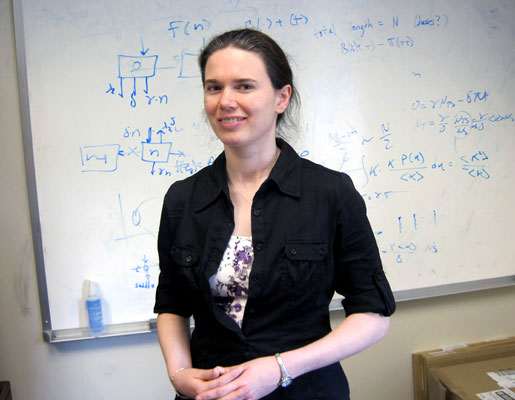Next stop: oblivion
Biomathematicians close in on the optimal route to extinction
Sometimes you want to prevent extinction. In other cases, you want to hurry extinction along.
Take, for instance, a cold virus hacking its way through an elementary school. Extinction of the virus within the student body is something everyone cheers for. It’s different when the goal is trying to stave off extinction in order to maintain a dwindling population of animals in the wild. Leah Shaw says there are many paths to extinction—no matter if you want to hasten extinction or try to stave it off—but, every system has one route to oblivion that’s most sure and direct.
Shaw, an assistant professor in William & Mary’s Department of Applied Science, works on the mathematical modeling of extinction. Shaw is a co-author of a paper outlining a model of the optimal path to extinction in the journal Interface, a publication of the British Royal Society. Understanding the mechanics of extinction is important in many regards, she says.
“First of all, it would be informative just to understand the system better. If you can understand how a part of a system goes extinct, you know something about the dynamics, you know what factors are important in the extinction,” she explained. “But the major reason for interest, of course, has to do with how you might control the extinction.”
She points out that extinctions are comparatively rare. In fact, Shaw’s group is studying some deterministic models—networks utterly without randomness—in which extinctions just don’t happen. “The population continues to exist at a stable level,” she explained. “Or epidemics persist indefinitely.”
All real systems have some degree of inherent randomness, though. To incorporate the real world’s pesky insistence on unpredictability, Shaw and her colleagues follow a stochastic, or probability-based, approach to modeling extinction.
“Because all systems are inherently random, there’s a slight chance that, for example, everybody infected with a disease could simultaneously recover,” Shaw explains, “and there’s a slight chance that an entire population could suddenly simultaneously die.”
Such extremes are unlikely, though, which means that extinction in a large population is, mathematically, an improbable proposition. But Shaw points out that small populations can be quite vulnerable to variations, phenomena best examined by the powerful predictive tools offered by mathematical modeling.
“If you have a real natural system, you can’t watch extinction many times to see how it happens. That’s not feasible,” she said. “But, numerically, we can simulate these systems. We have some element of randomness in the simulations, and we can do it many times and see how extinctions happen each time and compute some sort of average behavior.”
In their paper, “Converging Towards the Optimal Path to Extinction,” Shaw and her co-authors found that their models indicated that extinction can follow a number of routes, yet one route—the optimal route—was much more likely than any of the other possible paths to end at extinction. Shaw and her colleagues have found a number of road signs in their model pointing toward this optimal, most probable, route.
The paper shows that, for one thing, the optimal route appears to be very sensitive to initial conditions. After converting their stochastic model to a deterministic problem, the researchers borrowed some concepts from the deterministic concepts of chaos theory and classical mechanics used by physicists, and applied them to their essentially stochastic model.
“This work is already very interdisciplinary, in terms of biological systems that we’re trying to model mathematically,” Shaw said, “but it’s even more interdisciplinary in that we’re working in this math-physics area, and with stochastic systems becoming deterministic.”
The next step for Shaw and her collaborators is to investigate possible methods to intervene in the optimal path—to find methods in the model to try to either hasten extinction or stave it off.
“You would be interested in knowing the most probable path to extinction if you’re in a case where you only have limited control and you want to use it as effectively as possible,” she said. A practical example might be how to maximize the benefit of a limited amount of vaccine during a widespread epidemic, she explained.
One of the co-authors on the paper was Simone Bianco, who was Shaw’s post-doc at William & Mary and now is at the University of California, San Francisco. The other authors are Ira B. Schwartz of the Naval Research Lab and Eric Forgoston of Montclair University. ![]()
















